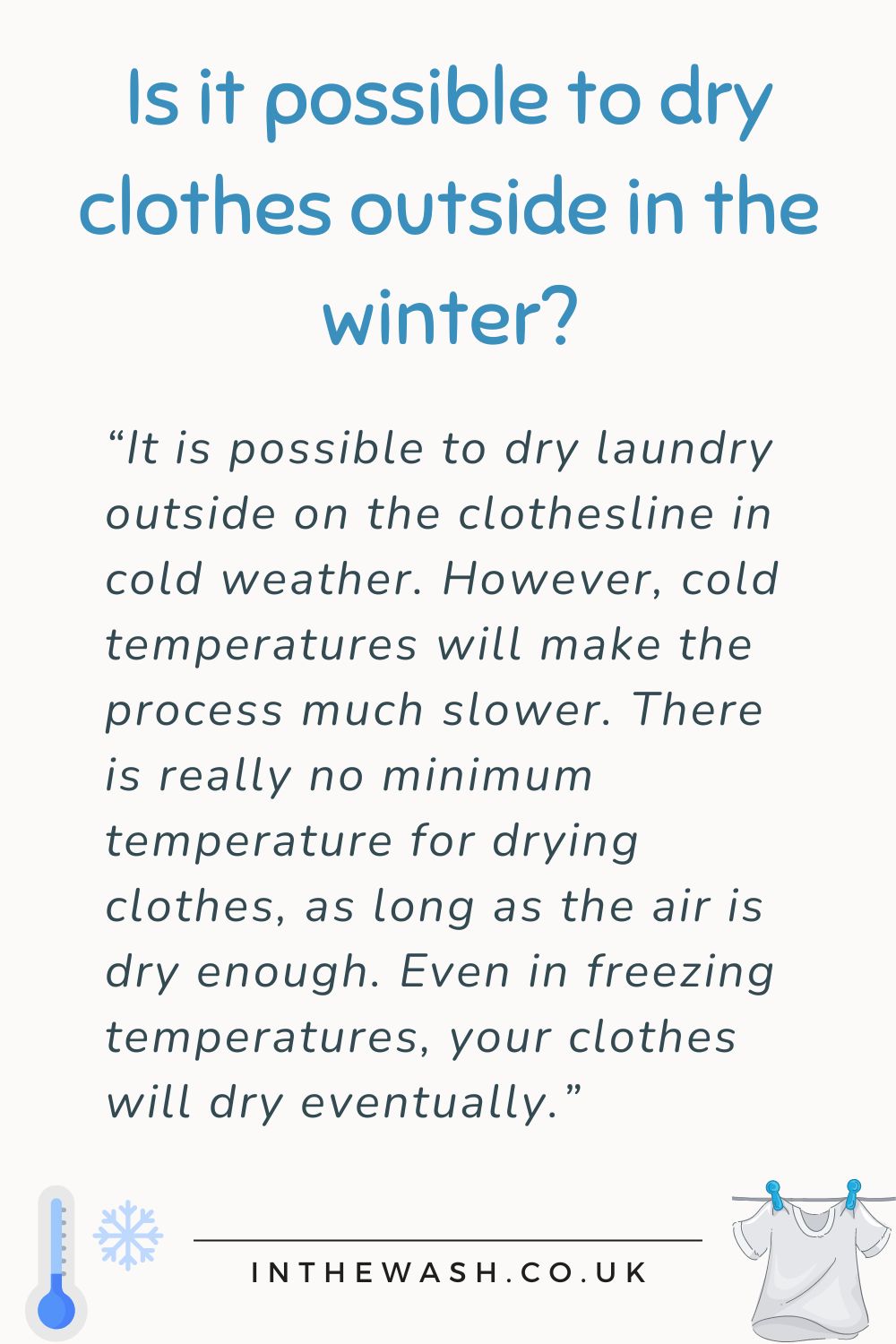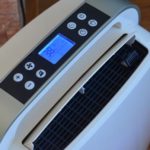Laundry is one of those inescapable tasks that need to be done on a regular basis, but it’s also one of the only modern-day chores that are still at the mercy of the elements.
Despite our many modern appliances, hanging laundry outside is still the best (and cheapest) way to get our clothes dry. This is all fine and dandy in the summertime, but winter weather can pose a challenge.
Tumble dryers are a common way to combat the UK’s cold, damp winters, but many people are hesitant to use a machine due to the financial and environmental cost of the energy involved.
Other common solutions are to drape clothes over radiators or hang them on an airer in a warm spot inside, but drying laundry inside can actually have some surprising health ramifications. It may seem impossible to dry your laundry outside during a UK winter, but it is worth a try if it’s sunny and windy enough.
Is It Possible to Dry Clothes Outside in the Winter?
Your laundry dries when water evaporates from your clothing into the surrounding air. There are a few factors involved in drying clothes:
- Heat
- Humidity
- Agitation (movement)
Ideally, every laundry day would provide sun (heat), dry air (low humidity) and wind (agitation), but we all know that’s not reality, especially in winter and especially in the UK.
It is possible to dry laundry outside on the clothesline in cold weather, however, cold temperatures will make the process much slower.
No matter the temperature, a sunny day will usually provide the conditions necessary to eventually get your clothes dry, especially with the addition of wind.
Humidity is where things get tricky. For evaporation to occur, the air around your clothes needs to be drier than your clothes themselves: the drier the air, the faster evaporation will occur.
Unfortunately, British winters are typically damp and rainy, making the process slower again.
What’s the Minimum Temperature for Drying Clothes Outside?
There is really no minimum temperature for drying clothes, as long as the air is dry enough. Even in freezing temperatures, your clothes will dry eventually.
Don’t worry if you find that your clothes have frozen on the line, the water will evaporate through a process of ‘sublimation’ whereby water converts directly from its solid-state (ice) into its gas state without going through its liquid stage.

Should You Dry Clothes Inside in the Winter?
While drying your clothes inside your home may seem like a convenient solution to winter weather (or be your only option if you don’t have a garden or balcony), this poses some health risks to both your family and your house.
Drying your laundry on radiators can create indoor pollution by releasing volatile organic compounds (VOCs) into the air. Chemicals from fabric dyes, detergent, fabric softener and so on can evaporate into the air as a result of being heated on a radiator.
Drying clothes inside also releases water into the air inside your house. Drying laundry inside typically increases interior humidity by 30% on laundry day and 15% overall, according to a study by the Mackintosh School of Architecture in Glasgow. This can be a real problem, particularly in poorly ventilated or well-insulated houses, as it encourages the growth of mould.
Mould spores can exacerbate asthma as well as causing a variety of health and respiratory problems, such as allergies, sinusitis, bronchitis, nausea, coughing, fatigue, headaches, eye, throat, and skin irritation.
How to Dry Clothes in the Winter Without a Tumble Dryer
Hanging clothes on the clothesline is the safest and cheapest way to dry your laundry, but for practical reasons, it can be a good idea to mix this method with some safe indoor drying practices.
If the weather outside is dry, it’s always worth using the clothesline, no matter what the temperature is. A bit of wind should go some way toward speeding up the drying process.
You can speed up the drying process with a few simple procedures, including:
- Use the highest spin cycle setting on your washing machine. A faster spin cycle will extract more water from your clothes before taking it out of the machine.
- Put your clothes on for an extra spin cycle. Most washing machines have the ability to complete an extra spin cycle, which will also help to remove any excess water from your clothing.
- Before hanging your clothes up, try rolling them up in a towel to soak up excess water. To do this, lay an absorbent towel on a flat surface. Spread one garment flat on the towel and roll them both up tightly like a Swiss Roll, then wring out. The towel should absorb excess moisture from the clothing, leaving garments just slightly damp. For best results, do one garment at a time, though you can roll-up several small items together, as long as they are not touching each other.
- Protect clothes from rain. Rain is often the reason that we are forced to bring our laundry inside before it’s dry. Try putting up a shelter in your garden under which you can put your laundry. A garden umbrella or fibreglass sheeting should be sufficient to keep the worst of the rain off your clothes.
- Use a drying rack outside. Rather than hanging your clothes on a clothesline, try putting them all on an airer or drying rack that can be easily transported. That way, you can pick up all of your clothes and move them indoors or outdoors quickly in the event of rain, without the hassle of pegging and unpegging everything from a set clothesline.
- Put clothes outside early in the day. Do your laundry first thing in the morning so that it has all day to hang outside in the sun.
- Plan your laundry days according to the weather forecast. Use the TV weather report or a phone app to track expected weather conditions and do your laundry at the start of sunny spells.
If your clothes aren’t able to fully dry by the time you need to bring them inside, hang them on an airer. Because your clothes should have partially dried outdoors, you will be releasing less water and VOCs into the interior air by just finishing them off inside.

Drying Clothes Indoors Safely
There are a few things you can do to make indoor drying safer, such as:
- Get clothes as dry as possible outdoors before bringing them inside.
- Buy a dehumidifier and place it near your laundry. This should soak up much of the moisture evaporating from your clothes and reduce the risk of mould. A range of dehumidifiers is available these days, from expensive machines to very affordable models.
- Place your laundry in a well-ventilated area, such as next to an open window. This may be impractical in extremely cold or rainy weather, but is probably the best way to ensure your home stays free of VOCs.
- Place your laundry in the kitchen or bathroom with the extractor fan on to draw out the moisture and VOCs from the air.
- If you have done the bulk of your drying outside and just a few sections like pockets or collars are still damp, use a warm blowdryer to target only the necessary areas.
- Be mindful of what chemicals you are applying to your laundry. Choose a natural soap or detergent that will release fewer toxic compounds into the air – see these mainly natural alternatives to washing powder.

In The Wash is your guide to the best laundry and cleaning products, tips and tricks. Our mission is to solve the UK’s cleaning and laundry dilemmas!







Drying clothes in an electric dryer may be an alternative but many people the cost is too great. Also because of the recent fires caused by tumble dryers many pensioners, older people and those with reduced mobility are frightened of using them. When I was a child (1940’s/ 1950’s local councils provided facilities (Drying Centres) where young mothers and the elderly could take their washing and dry it during the winter. Those were real days of Austerity and hardship. Why cant we afford to provide such a service for those in need today?
I give my washing a good spin then shake then hang it out if its a rainy day I dry off by having a coal fire
I live in Huddersfield, northern England and today, December 30th 2019, I dried my clothes outside! Even jeans! It was a lovely sunny, windy and mild day so I guess I was very lucky. I thought they’d at least partially dry but was shocked that they fully dried! I kept turning them around which helped 🙂